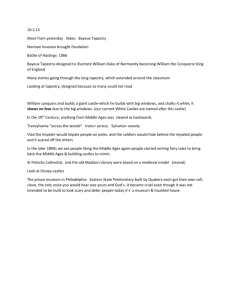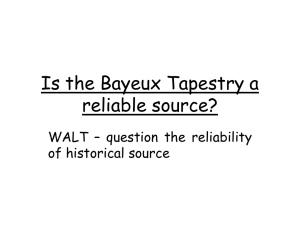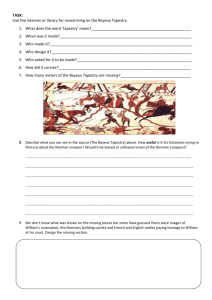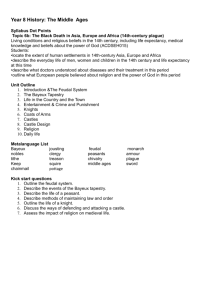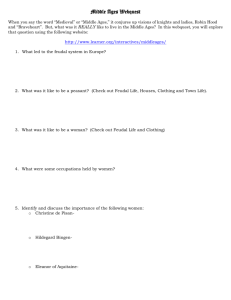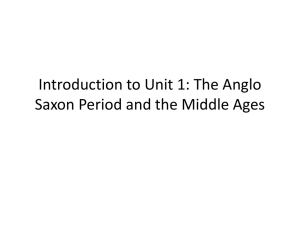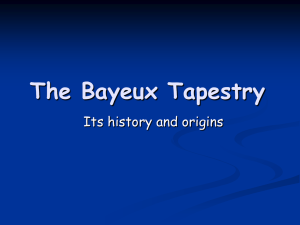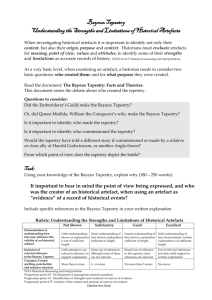Medieval Visual Culture
advertisement
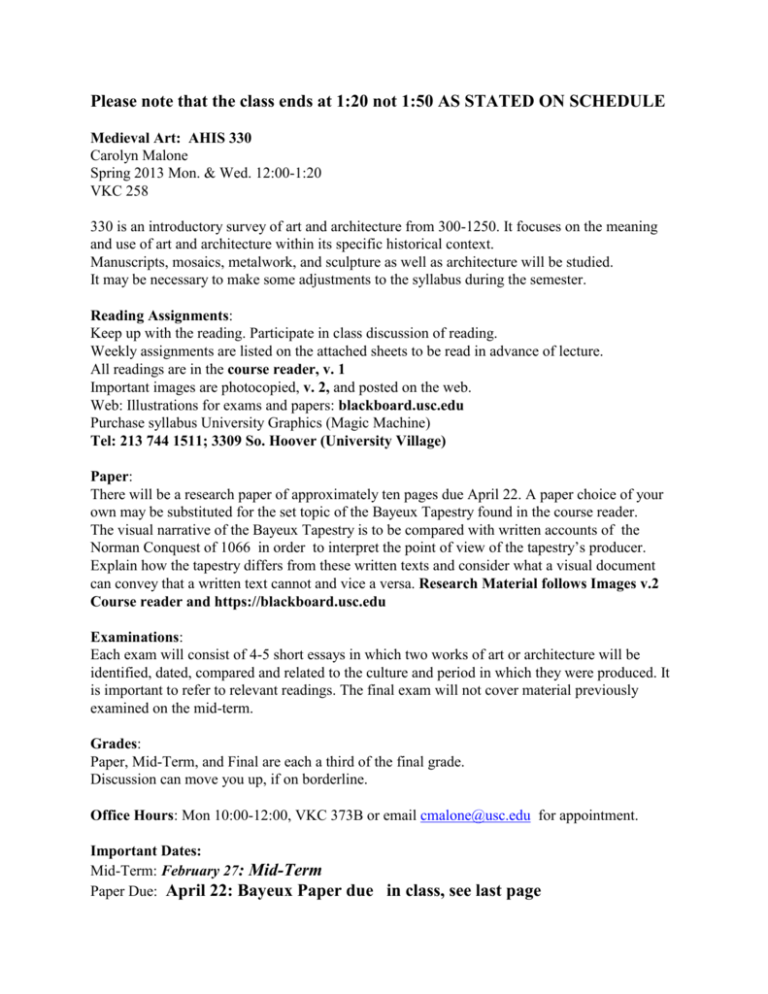
Please note that the class ends at 1:20 not 1:50 AS STATED ON SCHEDULE Medieval Art: AHIS 330 Carolyn Malone Spring 2013 Mon. & Wed. 12:00-1:20 VKC 258 330 is an introductory survey of art and architecture from 300-1250. It focuses on the meaning and use of art and architecture within its specific historical context. Manuscripts, mosaics, metalwork, and sculpture as well as architecture will be studied. It may be necessary to make some adjustments to the syllabus during the semester. Reading Assignments: Keep up with the reading. Participate in class discussion of reading. Weekly assignments are listed on the attached sheets to be read in advance of lecture. All readings are in the course reader, v. 1 Important images are photocopied, v. 2, and posted on the web. Web: Illustrations for exams and papers: blackboard.usc.edu Purchase syllabus University Graphics (Magic Machine) Tel: 213 744 1511; 3309 So. Hoover (University Village) Paper: There will be a research paper of approximately ten pages due April 22. A paper choice of your own may be substituted for the set topic of the Bayeux Tapestry found in the course reader. The visual narrative of the Bayeux Tapestry is to be compared with written accounts of the Norman Conquest of 1066 in order to interpret the point of view of the tapestry’s producer. Explain how the tapestry differs from these written texts and consider what a visual document can convey that a written text cannot and vice a versa. Research Material follows Images v.2 Course reader and https://blackboard.usc.edu Examinations: Each exam will consist of 4-5 short essays in which two works of art or architecture will be identified, dated, compared and related to the culture and period in which they were produced. It is important to refer to relevant readings. The final exam will not cover material previously examined on the mid-term. Grades: Paper, Mid-Term, and Final are each a third of the final grade. Discussion can move you up, if on borderline. Office Hours: Mon 10:00-12:00, VKC 373B or email cmalone@usc.edu for appointment. Important Dates: Mid-Term: February 27: Mid-Term Paper Due: April 22: Bayeux Paper due in class, see last page 2 Final Exam : May 10 Friday, 11 a.m.-1 p.m. Cheating and Plagiarism Cheating on exams will result in an automatic failure for the course. Plagiarism on a report/paper will result in a failure for the report or paper. Plagiarism: Plagiarism is the appropriation and subsequent passing off of another's ideas or words as one's own. If the words or ideas of another are used, acknowledgment of the original source must be made through recognized reference practices. Use of another's ideas or words must be properly acknowledged as follows: Direct Quotations: Any use of a direct quotation must be acknowledged by a footnote citation and by either quotation marks or appropriate indentation and spacing. Paraphrase: If another's ideas are borrowed in whole or in part and are merely recast in the student's own words, proper acknowledgment must, nonetheless, be made. A footnote or proper internal citation must follow the paraphrased material. The Types of Academic Dishonesty: 1. Submitting a paper written or obtained from another person. 2. Using another person to complete homework assignments or take-home exams without the knowledge and consent of the teacher. 3. Using a paper or essay in more than one class without the consent of the teacher. 4. Obtaining a copy of an examination in advance without the teacher’s consent. 5. Changing academic records outside of normal procedures and/or petitions. Statement for Students with Disabilities Any student requesting academic accommodations based on a disability is required to register with Disability Services and Programs (DSP) each semester. A letter of verification for approved accommodations can be obtained from DSP. Please be sure the letter is delivered to me as early in the semester as possible. DSP is located in STU 301 and is open 8:30 a.m.–5:00 p.m., Monday through Friday. The phone number for DSP is (213) 740-0776. Statement on Academic Integrity USC seeks to maintain an optimal learning environment. General principles of academic honesty include the concept of respect for the intellectual property of others, the expectation that individual work will be submitted unless otherwise allowed by an instructor, and the obligations both to protect one’s own academic work from misuse by others as well as to avoid using another’s work as one’s own. All students are expected to understand and abide by these principles. Scampus, the Student Guidebook, contains the Student Conduct Code in Section 11.00, while the recommended sanctions are located in Appendix A: http://www.usc.edu/dept/publications/SCAMPUS/gov/. Students will be referred to the Office of Student Judicial Affairs and Community Standards for further review, should there be any suspicion of academic dishonesty. The Review process can be found at: http://www.usc.edu/student-affairs/SJACS/. 3 Reading Schedule: COURSE READER Vol 1: Reference: From Abacus to Zeus, pp. 127-144. January 14: Introduction January 16 Murals in Dura Europus, Syria Mark, 1: 6-11: John 3: 5-6. (Baptism); Luke, 22: 12- 30. (Eucharist) G. Shiller, Iconography of Christian Art, pp. 5, 24-26, 127-130. H. Rahner, Greek Myths and Christian Mystery, 103-109. Lowden, Early Christian & Byzantine Art, excerpts. January 21: Holiday January 23: Murals in the Catacombs of Rome T. Buser, “Early Catacomb Iconography and Apocalypticism,” Studies in Iconography, pp.3-15. E. Maguire, "Introduction: Designs in Context,"Art and Holy Powers in the Early Christian House, excerpts January 28: Early Christian Architecture R. Stalley, Early Medieval Architecture, Oxford , 1999, pp. 24-27 C. Couasnon, The Holy Sepulcher in Jerusalem, excerpts. G. Vikan, Byzantine Pilgrimage Art, excerpts.. January 30: Early Fifth-Century Mosaics in Rome The Bible: Genesis: 13, 14:18-23( p. 18) , 18:1-15, 22:1-14-: (Abraham) T. Mathews, "Larger than Life,"The Clash of Gods, pp. 92-114; 203-206. Augustine, “Faith and Visual representation,” Early Medieval Art, ed. Davis-Weyer, pp. 43-44. February 4: Early Fifth-Century Mosaics in Rome D. Sieger, “Visual Metaphor as Theology: Leo the Great’s Sermons on the Incarnation and the Arch Mosaics of S. Maria Maggiore,” Gesta 1987:83-91. February 6: Mid-fifth and early-sixth century Mosaics in Ravenna A. Wharton, “Ritual and Reconstructed Meaning: The Neonian Baptistery in Ravenna,” The Art Bulletin 1987:358-375. T. Mathews, "Christ Chameleon,"The Clash of Gods, pp. 134-141; 208-209. February 11: Early-sixth century Mosaics in Ravenna T. Mathews, "Convergence,"The Clash of Gods, pp. 150-170. 4 February 13: Justinian and Empire The Bible: Genesis:4 T. Mathews, "Convergence,"The Clash of Gods, pp. 171-176 Otto von Simson, “San Vitale,” The Sacred Fortress, pp. 23-39. February 18: President’s Day Holiday February 20: Byzantine Architecture and Icons T. Mathews, “The icon, the Byzantine religious image,”Art and Architecture in Byzantium and Armenia,Variorium,1995,XIV, pp.9-13. T. Mathews, "The Clash of Gods, “The Intimate Icon,” pp. 177, 184-190. February 25: Mid-Term Review February 27: Mid-Term March 4: Irish monasticism and Hiberno-Saxon art Beowulf, trans. Raffel, pp. 28-29, 118-121. Diebold, Word and Image, pp. 20-41 March 6: Carolingian: First Half of 9th c. R. Stalley, Early Medieval Architecture, excerpts on Aachen, S. Gall, Corvey. W. Horn , The Plan of St. Gall , 20-25. The Rule of St. Benedict, 52-61, 70-71, 78-83, 86-91. March 11: Carolingian: Second Half of 9th c. R. Deshman, “The Exalted Servant: the Ruler Theology of the Prayerbook of Charles the Bald,” Viator 11 (1980), pp. 384-404,414-417. March 13: Ottonian Revival and Innovation R. Stalley, Early Medieval Architecture, pp. 53-57. March 18-23 Spring Break March 25: Ottonian Empire H. Mayr-Harting, “Christ-centered Kingship,” “Otto III and Henry II,” Ottonian Book Illumination, pt.1, pp. 57-68; 157-164, 196-200 March 27: The year 1000 & Ottonian and Spanish Apocalyptic Manuscripts The Bible, Apocalypse (Revelation): 4. 5 H. Mayr-Harting, “Bamberg Apocalyptic Manuscripts,” Ottonian Book Illumination, pt 2, excerpts. April 1: The Pilgrimage church R. Stalley, Early Medieval Architecture, excerpts. Haec Dies, gradual & Dies Irae, versus (class handout) . April 3: Romanesque sculpture: Women & Judgment M. Schapiro, Romanesque Art, pp. 37-38, 118-119, 201-203. (+Luke) D. Denny, “The last Judgment Tympanum at Autun: Its Sources and Meaning,” Speculum 57(1982): 542-547. M. Miles, Carnal Knowing, (Boston, 1989), pp. 99-105,114-116. (scan) Hildegard von Bingen, Mystical Visions, trans. B. Hozeski, excerpts. H. Kraus, The Living Theater of Medieval Art, pp. 41-50.(scan) April 8: Romanesque sculpture: Crusading propaganda & the ‘Other’ H. Kraus, The Living Theater of Medieval Art, pp. 139-162. A. Katzenellenbogen, “The Central Tympanum at Vezelay, “The Art Bulletin 1944:141-151. P. Sheingorn, “”For God is Such a Doomsman,’Homo,Memento Finis: The Iconography of Just Judgment,” Medieval Art & Drama April 10: Benedictine vs. Cistercian monasticism and architecture R. Stalley, Early Medieval Architecture, pp. 168-171, 176-177. Holt, Bernard of Clairvaux, v.I.,Documentary History of Art, pp. 18-22. April 15:. Saint-Denis and Early Gothic Sculpture Holt, Suger, Documentary History of Art, pp. 28-37, . O. Von Simson, The Gothic Cathedral, pp. 91, 100-103,116-123. A. Katzenellenbogen, Chartres, pp. 10-25. April 17: Gothic Architecture L. H. Stookey, "The Gothic Cathedral as the Heavenly Jerusalem: Liturgical and Theological Sources."Gesta 8(1969):35-39. April 22: Bayeux Paper due in class, see last page April 22: Gothic and Rayonnant Architecture E. Panofsky, Gothic Architecture & Scholasticism,pp. 20-33, 36-45. April 24: High Gothic Sculpture A. Katzenellenbogen, Chartres, pp. 56-69, 76-78. April 29: Mid-Term Review 6 Mid-Term May 10 Friday, 11 a.m.-1 p.m. Paper: Bayeux Paper due April 22: in class, In 10 pages discuss the narrative of the Norman Conquest of England as presented in the Bayeux Tapestry. In a well-written essay consider the questions listed below after reading the primary textual accounts of the Norman Conquest of 1066 in the following three historical documents: 1. The Anglo-Saxon Chronicle 2. Harold's Saga 3. William of Poitiers Research Material follows Images v.2 See also Paper Web Images Consider which of these texts relate to the images on the basis of your own comparison. One of these texts is significantly more important than the other two. Be certain to look at the colored reproductions posted on the web. Note that the divisions of the black and white photos in your xerox are different. Note also that pp. 232 ff. of the xerox translates in Capital Letters the Latin text embroidered on the tapestry. In your essay consider the following questions in any order, and add any other observations or concepts that you like. 1. What are the most important moments of the narrative depicted in the tapestry? 2. Which of the three texts corresponds most closely with the illustrations of the tapestry? How do the drawings support the political position of the tapestry? 3. What information is conveyed by the illustrations that is not contained in the written texts? 4. How do the illustrations make several historical points more emphatic? 5. What is explained better by the written text? 6. From whose viewpoint is the narrative depicted? 7. Who do you think produced this tapestry and what was the ideological position of this patron? 8. In addition to the politics of the Conquest, what does the tapestry reveal about late eleventhcentury customs, social life, and material culture?
